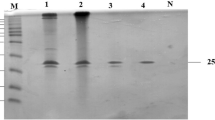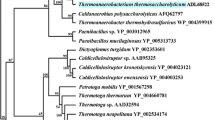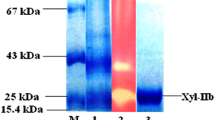Abstract
Streptomyces sp. CS802, recently isolated from Korean soil, produced xylanase in corncob medium. An extracellular xylanase (Xyn802) was purified by a single-step gel filtration and biochemical properties were studied. It showed high activity in extremely alkaline condition with optimum pH at 12.0 and exhibited stability between pH 7.5 and 13.0. It produced xylobiose and xylotriose as the major products from xylan, suggesting its endoxylanase nature. N-terminal amino acid sequences of Xyn802 were ADRNANRD which are significantly different from the reported xylanase. The activity was enhanced by various detergents and a reducing agent and stable in various organic solvents. Xyn802 produced by utilizing corncob, an agro-waste material, might be a novel xylanase based on its peculiar biochemical characteristics, and it can be a suitable candidate for the production of xylooligosaccharides including other useful products.



Similar content being viewed by others
References
Shin, J.-H., Choi, J.-H., Lee, O.-S., Kim, Y.-M., Lee, D.-S., Kwak, Y.-Y., Kim, W.-C., & Rhee, I.-K. (2009). Thermostable xylanase from Streptomyces thermocyaneoviolaceus for optimal production of xylooligosaccharides. Biotechnology and Bioprocess Engineering, 14, 391–399.
Ai, Z., Jiang, Z., Li, L., Deng, W., Kusakabe, I., & Li, H. (2005). Immobilization of Streptomyces olivaceoviridis E-86 xylanase on Eudragit S-100 for xylo-oligosaccharide production. Process Biochemistry, 40, 2707–2714.
Vázquez, M. J., Alonso, J. L., Domínguez, H., & Parajó, J. C. (2000). Xylooligosaccharides: manufacture and applications. Trends in Food Science and Technology, 11, 387–393.
Sun, Y., & Cheng, J. (2002). Hydrolysis of lignocellulosic materials for ethanol production: a review. Bioresource Technology, 83, 1–11.
Beg, Q. K., Kapoor, M., Mahajan, L., & Hoondal, G. S. (2001). Microbial xylanases and their industrial applications: a review. Applied Microbiology and Biotechnology, 56, 326–338.
Collins, T., Gerday, C., & Feller, G. (2005). Xylanases, xylanase families and extremophilic xylanases. FEMS Microbiology Reviews, 29, 3–23.
Yan, Q., Hao, S., Jiang, Z., Zhai, Q., & Chen, W. (2009). Properties of a xylanase from Streptomyces matensis being suitable for xylooligosaccharides production. Journal of Molecular Catalysis B: Enzymatics, 58, 72–77.
Georis, J., Giannotta, F., De Buyl, E., Granier, B., & Frère, J.-M. (2000). Purification and properties of three endo-[beta]-1,4-xylanases produced by Streptomyces sp. strain S38 which differ in their ability to enhance the bleaching of kraft pulps. Enzyme and Microbial Technology, 26, 178–186.
Ninawe, S., Kapoor, M., & Kuhad, R. C. (2008). Purification and characterization of extracellular xylanase from Streptomyces cyaneus SN32. Bioresource Technology, 99, 1252–1258.
Kaneko, S., Kuno, A., Muramatsu, M., Iwamatsu, S., Kusakabe, I., & Hayashi, K. (2000). Purification and characterization of a family G/11 xylanase from Streptomyces olivaceoviridis E-86. Bioscience, Biotechnology, and Biochemistry, 64, 447–451.
Wang, S.-L., Yen, Y.-H., Shih, I.-L., Chang, A. C., Chang, W.-T., Wu, W.-C., & Chai, Y.-D. (2003). Production of xylanases from rice bran by Streptomyces actuosus A-151. Enzyme and Microbial Technology, 33, 917–925.
Li, X., She, Y., Sun, B., Song, H., Zhu, Y., Lv, Y., & Song, H. (2010). Purification and characterization of a cellulase-free, thermostable xylanase from Streptomyces rameus L2001 and its biobleaching effect on wheat straw pulp. Biochemical Engineering Journal, 52, 71–78.
Nanmori, T., Watanabe, T., Shinke, R., Kohno, A., & Kawamura, Y. (1990). Purification and properties of thermostable xylanase and beta-xylosidase produced by a newly isolated Bacillus stearothermophilus strain. Journal of Bacteriology, 172, 6669–6672.
Simkhada, J., Cho, S., Choi, H., Kim, S., Lee, H., Sohng, J., & Yoo, J. (2010). A new thermolabile alkaline phospholipase D from Streptomyces sp. CS628. Biotechnology and Bioprocess Engineering, 15, 595–602.
Bradford, M. M. (1976). A rapid and sensitive method for the quantitation of microgram quantities of protein utilizing the principle of protein-dye binding. Analytical Biochemistry, 72, 248–254.
Miller, G. L. (1959). Use of dinitrosalicylic acid reagent for determination of reducing sugar. Analytical Chemistry, 31, 426–428.
Laemmli, U. K. (1970). Cleavage of structural proteins during the assembly of the head of bacteriophage T4. Nature, 227, 680–685.
Sriyapai, T., Somyoonsap, P., Matsui, K., Kawai, F., & Chansiri, K. (2011). Cloning of a thermostable xylanase from Actinomadura sp. S14 and its expression in Escherichia coli and Pichia pastoris. Journal of Bioscience and Bioengineering, 111, 528–536.
Samanta, A. K., Senani, S., Kolte, A. P., Sridhar, M., Sampath, K. T., Jayapal, N. and Devi, A (2012). Production and in vitro evaluation of xylooligosaccharides generated from corn cobs. Food and Bioproducts Processing (in press)
Kumar, A., Gupta, R., Shrivastava, B., Khasa, Y. P., & Kuhad, R. C. (2012). Xylanase production from an alkalophilic actinomycete isolate Streptomyces sp. RCK-2010, its characterization and application in saccharification of second generation biomass. Journal of Molecular Catalysis B: Enzymatics, 74, 170–177.
Morosoli, R., Bertrand, J. L., Mondou, F., Shareck, F., & Kluepfel, D. (1986). Purification and properties of a xylanase from Streptomyces lividans. Biochemical Journal, 239, 587–592.
Deesukon, W., Nishimura, Y., Harada, N., Sakamoto, T., & Sukhumsirichart, W. (2011). Purification, characterization and gene cloning of two forms of a thermostable endo-xylanase from Streptomyces sp. SWU10. Process Biochemistry, 46, 2255–2262.
Qiu, Z., Shi, P., Luo, H., Bai, Y., Yuan, T., Yang, P., Liu, S., & Yao, B. (2010). A xylanase with broad pH and temperature adaptability from Streptomyces megasporus DSM 41476, and its potential application in brewing industry. Enzyme and Microbial Technology, 46, 506–512.
Zhou, J., Shi, P., Zhang, R., Huang, H., Meng, K., Yang, P., & Yao, B. (2011). Symbiotic Streptomyces sp. TN119 GH 11 xylanase: a new pH-stable, protease- and SDS-resistant xylanase. Journal of Industrial Microbiology and Biotechnology, 38, 523–530.
Kim, D. Y., Han, M. K., Oh, H.-W., Park, D.-S., Kim, S.-J., Lee, S.-G., Shin, D.-H., Son, K.-H., Bae, K. S., & Park, H.-Y. (2010). Catalytic properties of a GH10 endo-β-1,4-xylanase from Streptomyces thermocarboxydus HY-15 isolated from the gut of Eisenia fetida. Journal of Molecular Catalysis B: Enzymatics., 62, 32–39.
Giridhar, P. V., & Chandra, T. S. (2010). Production of novel halo-alkali-thermo-stable xylanase by a newly isolated moderately halophilic and alkali-tolerant Gracilibacillus sp. TSCPVG. Process Biochemistry, 45, 1730–1737.
Taneja, K., Gupta, S., & Chander Kuhad, R. (2002). Properties and application of a partially purified alkaline xylanase from an alkalophilic fungus Aspergillus nidulans KK-99. Bioresource Technology, 85, 39–42.
Klibanov, A. M. (2001). Improving enzymes by using them in organic solvents. Nature, 409, 241–246.
Verma, D., & Satyanarayana, T. (2012). Cloning, expression and applicability of thermo-alkali-stable xylanase of Geobacillus thermoleovorans in generating xylooligosaccharides from agro-residues. Bioresource Technology, 107, 333–338.
Techapun, C., Poosaran, N., Watanabe, M., & Sasaki, K. (2003). Thermostable and alkaline-tolerant microbial cellulase-free xylanases produced from agricultural wastes and the properties required for use in pulp bleaching bioprocesses: a review. Process Biochemistry, 38, 1327–1340.
Acknowledgments
This work was supported by research fund from Chosun University, 2012.
Author information
Authors and Affiliations
Corresponding authors
Additional information
Jaya Ram Simkhada and Hah-Young Yoo contributed equally to this work.
Rights and permissions
About this article
Cite this article
Simkhada, J.R., Yoo, HY., Choi, Y.H. et al. An Extremely Alkaline Novel Xylanase from a Newly Isolated Streptomyces Strain Cultivated in Corncob Medium. Appl Biochem Biotechnol 168, 2017–2027 (2012). https://doi.org/10.1007/s12010-012-9914-2
Received:
Accepted:
Published:
Issue Date:
DOI: https://doi.org/10.1007/s12010-012-9914-2




